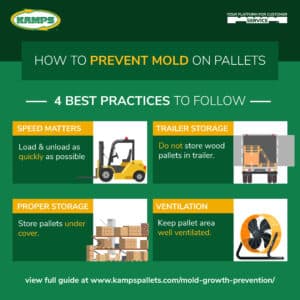Mold on pallets is a very common problem in the wood packaging industry, especially with recycled pallets. This is problematic for our food industry customers, as the food safety requirements for pallets are becoming increasingly strict. Given the range of conditions the pallets at our Kamps plants across the country endure, it is particularly important we do everything possible to help prevent mold growth or react quickly to destroy it, if molding does occur.
Where Can You Find Mold?
It’s hard to believe that mold spores are in the air around us almost all the time, looking for their new home. As awful as it sounds, it’s true.
Mold only needs the right conditions to grow and proliferate. Mold spores need oxygen, food, and moisture to grow – if one of these three ingredients is missing, mold will not grow. The food mold seeks to consume are the pallets themselves.
Common Misconceptions About Mold Control
Heat treatment is often looked as a solution for mold on pallets, but, surprisingly, it’s not.
While heat treatments kills wood borne insects, it does not prevent the growth of mold. Heat treatment helps draw out the moisture in pallets and brings it to the surface.
As mentioned, moisture is one of the key ingredients in the mold growing formula. Once the pallets are taken out of the heat treating chamber, they are now the perfect breeding ground for mold growth. With the moisture on the surface, they merely wait for a mold spore to land upon them.
How To Prevent Mold Growth
Sealing Wood from Oxygen
A common treatment to help combat mold is using chemicals to help seal the wood from oxygen.
This creates a strong barrier and decreases the possibility of mold growth.
Keep The Pallets Dry
Most importantly, however, the pallets need to be kept as dry as possible and in an area that ideally experiences good airflow.
Without moisture, mold cannot grow.
Make sure to store pallet material and finished pallets under cover or inside your warehouse to keep pallets dry and less susceptible to mold. There are also industrial-grade fans that can be used to keep areas well ventilated.
Once the pallets leave your facility and are now at your customer’s warehouse, the chance for mold growth doesn’t stop! Customers should unload and load trucks as quickly as possible.
Also, do not store wooden pallets on a trailer. Again: do not store wooden pallets in trailers. Trailers quickly turn into incubators for mold growth because of the humidity and lack of airflow in these enclosed spaces.
At Kamps, we utilize these strategies to help our customers nationwide avoid mold on our wood pallets.
If issues do arise, we are able to quickly react and get replacements to our customers to ensure there are no interruptions to their production. If you have issues with mold growth, please let us know so that we can help right away!
Quick summary of our guide to share or hang in your warehouse:

(click image to expand & save)
Update: This page was initially published 6/26/19, and updated on 6/01/22
